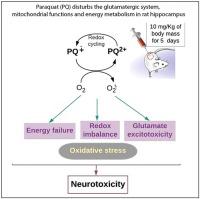NeuroToxicology ( IF 3.4 ) Pub Date : 2021-05-25 , DOI: 10.1016/j.neuro.2021.05.010 Nathalia Ferrazzo Naspolini 1 , Carla Elise Heinz Rieg 1 , Vitoria Hayduck Cenci 1 , Daiane Cattani 1 , Ariane Zamoner 1

|
Paraquat (1,1′-dimethyl-4,4′-bipyridinium dichloride; PQ) is a widely used herbicide in Brazilian crops, despite its banishment in many other countries. The present study investigated the effects of repeated dose of PQ on glutamate system, energy metabolism and redox parameters in the hippocampus of prepubertal rats. Twenty-two-day-old rats received daily intraperitoneal injections of PQ (10 mg/Kg) during 5 consecutive days and the effects of the pesticide were assessed 24 h after the last injection. The PQ exposure provoked cytotoxicity associated to decreased cell viability and increased glutamate excitotoxicity, as demonstrated by decreased 14C-glutamate uptake and increased 45Ca2+ uptake. Downregulated glutamine synthetase (GS) activity, further supports disrupted glutamate metabolism compromising the glutamate-glutamine cycle. Downregulated 14C-2-Deoxy-D-glucose indicates energy failure and upregulated lactate dehydrogenase (LDH) suggests the relevance of lactate as energy fuel. Aspartate aminotransferase (AST) and alanine aminotransferase (ALT) upregulation suggest Krebs cycle replenishment and piruvate production. In addition, PQ disturbed the redox status inducing lipid peroxidation, evaluated by increased TBARS and imbalanced antioxidant system. Downregulated glutathione reductase (GR), gamma-glutamyltransferase (GGT), glutathione-S-transferase (GST) and glucose-6-P-dehydrogenase (G6PD) activities together with upregulated superoxide dismutase (SOD) and catalase activities corroborate the oxidative imbalance. The mechanisms underlying PQ-induced neurotoxicity involves the modulation of GSK-3β, NF-κB and NMDA receptors. These neurochemical and oxidative events observed may contribute to neuroinflammation and neurotoxic effects of PQ on hippocampal cells.
中文翻译:

百草枯诱导氧化还原失衡并破坏青春期前大鼠海马的谷氨酸和能量代谢
百草枯 (1,1'-dimethyl-4,4'-bipyridinium dichloride; PQ) 是巴西作物中广泛使用的除草剂,尽管它在许多其他国家被禁止使用。本研究调查了重复剂量百草枯对青春期前大鼠海马谷氨酸系统、能量代谢和氧化还原参数的影响。22 日龄大鼠连续 5 天每天腹腔注射百草枯 (10 mg/Kg),并在最后一次注射后 24 小时评估农药的效果。PQ 暴露引起与细胞活力降低和谷氨酸兴奋性毒性增加相关的细胞毒性,如 14C-谷氨酸摄取减少和45 Ca 2+增加所示摄取。下调谷氨酰胺合成酶 (GS) 活性,进一步支持破坏谷氨酸代谢,损害谷氨酸-谷氨酰胺循环。下调14C-2-脱氧-D-葡萄糖表明能量衰竭,上调的乳酸脱氢酶 (LDH) 表明乳酸作为能量燃料的相关性。天冬氨酸氨基转移酶 (AST) 和丙氨酸氨基转移酶 (ALT) 上调表明克雷布斯循环补充和丙酮酸产生。此外,PQ 扰乱了诱导脂质过氧化的氧化还原状态,通过增加的 TBARS 和不平衡的抗氧化系统来评估。下调的谷胱甘肽还原酶 (GR)、γ-谷氨酰转移酶 (GGT)、谷胱甘肽-S-转移酶 (GST) 和葡萄糖-6-P-脱氢酶 (G6PD) 活性以及上调的超氧化物歧化酶 (SOD) 和过氧化氢酶活性证实了氧化失衡。PQ 诱导的神经毒性的机制涉及 GSK-3β、NF-κB 和 NMDA 受体的调节。











































 京公网安备 11010802027423号
京公网安备 11010802027423号